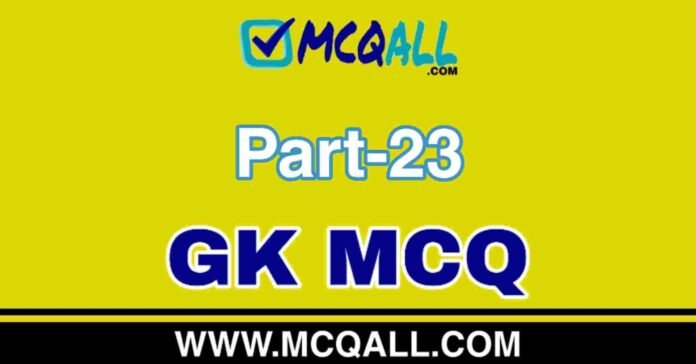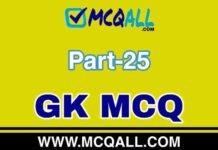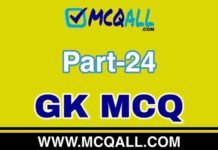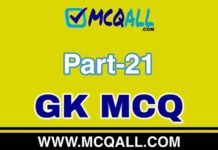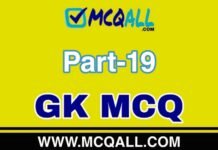General Knowledge – GK MCQ Question and Answer Part-23
General Knowledge – GK MCQ Question and Answer Part-23 : General Knowledge – GK MCQ Question and Answer Part-23 is given below. This General Knowledge – GK MCQ Part-23 / General Knowledge Part-23 – GK Quiz / General Knowledge Part-23 – GK Question and Answer / General Knowledge Part-23 – GK Multiple Choice Question, Short Question, Question and Answer, Suggestion, Notes are very important for school, college and various competitive or job exams and interviews.
Those of you who are looking for General Knowledge – GK MCQ Question and Answer Part-23, can read the questions and answers given below.
General Knowledge – GK MCQ Part-23
- Who is the Science and Technology and Bio-Technology Minister of West Bengal ?
(A) Subrata Mukherjee
(B) Bratya Basu
(C) Jyotipriyo Mullick
(D) Arup Biswas
Answer : Bratya Basu
Solution: Bratya Basu is the Science and Technology and Bio-Technology Minister of West Bengal.
- What is West Bengal’s life expectancy ?
(A) 90
(B) 65.7
(C) 70.8
(D) 82.65
Answer : 70.8
Solution: West Bengal’s life expectancy 70.8 .
- How old is Bengali language ?
(A) About 2000 years
(B) About 1500 years
(C) About 1300 years
(D) About 1700 years
Answer : About 1300 years
Solution: Bengali has developed over the course of more than 1,300 years. Bengali literature, with its millennium-old literary history, has extensively developed since the Bengali Renaissance and is one of the most prominent and diverse literary traditions in Asia.
- During the liberation struggle, what was the “Aradhan” preserved all over Bengal?
(A) The Rowlatt Act
(B) Partition of Bengal
(C) Non-Cooperation Movement
(D) Chiyatorer Manhantar
Answer : Partition of Bengal
Solution: During the liberation struggle, “Arandahan” was preserved throughout Bangla during the Partition of Bengal protests.
- Which Nawab of Dhaka supported the partition of Bengal?
(A) Nawab Salimullah
(B) Nawab Asmatullah
(C) Nawab Omar Mirza
(D) None of the above
Answer : Nawab Salimullah
Solution: When Lord Curzon visited Dhaka in 1903, Nawab Salimullah addressed the problems of East Bengal. Meanwhile, the British were thinking of using the Chittagong port instead of Kolkata to reduce the cost of transporting Tea and other commodities produced by Assam, as well as the idea of decentralizing the administration of the Bengal Presidency. With the commercial interests of the British and the application of the Nawab within a short time, a final decision was made to divide Bengal and the Nawab supported the partition. In spite of this, a separate province with East Bengal and Assam was formed in 1905, despite intense protests by the intellectuals of Kolkata-based intellectuals.
- Who was the editor of the “Sandhya” Paper ?
(A) Ishwar Chandra Vidyasagar
(B) Dayanand Saraswati
(C) Brahmabandh Upadhyaya
(D) Prince Dwarka Nath Tagore
Answer : Brahmabandh Upadhyaya
Solution: The editor of “Sandhya” is the Brahmabandh Upadhyaya.
- In Which year did the “Kol” rebellion begin?
(A) 1831
(B) 1839
(C) 1821
(D) 1747
Answer : 1831
Solution: Coal revolt was one of the indigenous uprisings against British rule in the mid-nineteenth century. From ancient times, the Kol tribe started living in Singhabam, Manbhum, Chhota Nagpur and other areas of present Bihar. The cholera was divided into communities like Ho, Munda, Oraon. They are mainly forest dwellers and freedom fighters. Until the eighteenth century, the coals remained independent. But with the introduction of colonial rule in India, indigenous peoples were tied to the principle of exploitation of British power. Cholera, like other primitive nations, was an agriculturalist. As part of the new land revenue system, the English government appointed foreigners as landlords of the Kol community. They attacked the coal society by changing the judiciary and the law system with high revenues, and these exploits and deprivation led to the start of the coal revolt in 1831. Agricultural dissatisfaction was at the root of the Coal Rebellion in general.
- Who was called “Surrender Not” ?
(A) Subhash Chandra Bose
(B) Surendranath Bandopadhyay
(C) Aurobindo Ghosh
(D) Baghajatin
Answer : Surendranath Bandopadhyay
Solution: Surendranath Bandopadhyay .
- Pragjyotispur is the old name of which city ?
(A) Kolkata
(B) Patna
(C) Dhaka
(D) Guwahati
Answer : Guwahati
Solution: Pragjyotispur was a historic city ruled by the medieval Barman dynasty in present-day Guwahati, the capital of the state of Kamrup. After the seventh century AD, the name of Pragjyotispur was introduced. Further, Pragjyotispur, Pragjyotispur was the state and capital.
- In which year was the “Babughat” established ?
(A) 1800
(B) 1791
(C) 1827
(D) 1830
Answer : 1830
Solution: Babughat” established was 1830.
GK MCQ Question and Answer
See also: – GK MCQ Question and Answer Click Here
General Knowledge – GK MCQ Question and Answer Part-23
General Knowledge – GK MCQ Question and Answer Part-23: General Knowledge – GK MCQ Question and Answer Part-23 – General Knowledge – GK MCQ Question and Answer Part-23 has been discussed above.
General Knowledge Part-23 – GK Multiple Choice Question and Answer
General Knowledge Part-23 – GK Multiple Choice Question and Answer: General Knowledge Part-23 – GK Multiple Choice Question and Answer – General Knowledge Part-23 – GK Multiple Choice Question and Answer discussed above.
General Knowledge Part-23 – GK Quiz
General Knowledge Part-23 – GK Quiz : General Knowledge Part-23 – GK Quiz – General Knowledge Part-23 – GK Quiz has been discussed above.
General Knowledge Part-23 – GK Questions and Answers in English
General Knowledge Part-23 – GK Questions and Answers in English: General Knowledge Part-23 – GK Questions and Answers in English – General Knowledge Part-23 – GK Questions and Answers in English.
General Knowledge – GK MCQ Question and Answer Part-23
If you benefit from this ” General Knowledge – GK MCQ Question and Answer Part-23 ” post then our efforts will be successful. Also visit our MCQALL.COM website to know MCQ – Multiple Choice Question Quiz on various topics, questions and answers quiz from GK and Daily Current Affairs, Thank you.

